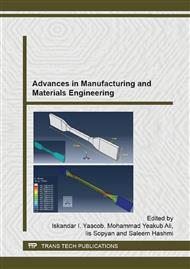p.410
p.414
p.418
p.422
p.426
p.433
p.440
p.446
p.450
Low-Cost Synthesis and Characterizations of Metal-Organic Framework (MOF-199) Materials by Nonsurfactant Templating Method
Abstract:
In this study, a three-dimensional (3D) copper-based metal-organic framework (MOF-199) is a microporous materials with structural formula Cu3(BTC)2 (1,3,5-benzene tricarboxylate) were successfully synthesized using nonsurfactant templating method. The preparations of MOF-199 utilized different length of straight carbon chain (oleochemical) fatty alcohols derived from palm oil were similar to those reported earlier by our group with some modifications [1]. This new method led to unique structure and properties of as-synthesized MOF-199. The addition of fatty alcohols such as octyl (C8) and decyl (C10) alcohol act as renewable template onto MOF-199 generating the required carbon template for microporous crystalline structure [2]. The MOF-199 had been synthesized using conventional hydrothermal method with the present of fatty alcohols to analyse the resulting MOF-199 in terms of structure, morphology, surface area and adsorption isotherm. MOF-199 synthesized in this study exhibited single crystal orthorhombic morphology at ca. 30 micron. The crystallinity of MOF-199 materials was improved by the addition of fatty alcohols as observed in the X-Ray Diffraction patterns.
Info:
Periodical:
Pages:
426-429
Citation:
Online since:
July 2015
Price:
Сopyright:
© 2015 Trans Tech Publications Ltd. All Rights Reserved
Share:
Citation:


